
The Basilica of Santa Maria di Campagna is a Roman Catholic basilica church in the city of Piacenza in the Province of Piacenza, Italy. It was built in a Greek-Cross plan with an octagonal dome in a high Renaissance style in the 16th century.

The Basilica of Santa Maria di Campagna is a Roman Catholic basilica church in the city of Piacenza in the Province of Piacenza, Italy. It was built in a Greek-Cross plan with an octagonal dome in a high Renaissance style in the 16th century.

It was built in 1522–28, under the patronage of a local guild. The site had housed a sanctuary dedicated to Santa Maria di Campagnola, and housed a wooden image of the Madonna and Child from the 14th century. Tradition holds that Pope Urban II in 1095 announced the First Crusade from this site.
The architect of the Renaissance church was the native Alessio Tramello. Among the artists active inside the church were Camillo Procaccini, and Gaspare Traversi. The sacristy contains canvases by Gaspare Landi and Giulio Campi. The Chapel of Saint Anthony has works by Pietro Antonio Avanzini, Camillo Procaccini, and a member of the Galli-Bibiena Family. In the south transept are works of Alessandro Tiarini, Antonio Triva, and Ignazio Stern. The Chapel of Santa Vittoria Martire has works by Ferrante Moreschi, Bernardino Gatti (St George slaying the Dragon), Paolo Bozzini, Ludovico Pesci and Daniele Crespi. The nave ceiling has paintings by the 19th-century painter Giovanni Battista Ercole.
Among the masterpieces of the church are the frescoes by Giovanni Antonio Sacchi (Il Pordenone) and Bernardino Gatti in the cupola. They include depiction of the four evangelists in the spandrels. Pordenone also painted a fresco altarpiece in the Chapel of the Magi, depicting the arrival of the three Magi to visit the newborn Jesus. The Magi include a man of African descent and men dressed in elaborate Turkish garb. To the left of this fresco is another by the same artist depicting the Birth of the Virgin. Finally in the chapel of St Catherine are frescoes by Pordenone depicting St Catherine debates with the philosophers (Disputa di Santa Caterina) and the Mystical Marriage of St Catherine.
The marble pavement was completed by the Milanese artist, Giambattista Carrà (1595). The statue of Ranuccio I Farnese was carved in 1616 by the Baroque sculptor Francesco Mochi. [1]
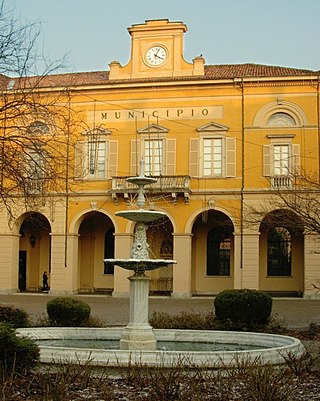
Mortara is a comune (municipality) in the province of Pavia, in the Italian region of Lombardy. It lies between the Agogna and Terdoppio rivers, in the historical district known as Lomellina, a rice-growing agricultural center. It received the honorary title of city with a royal decree in 1706.
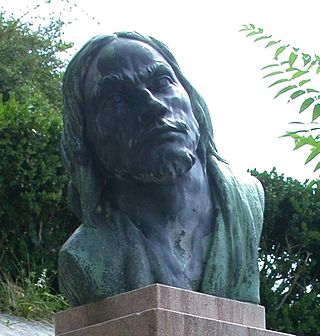
Pordenone, Il Pordenone in Italian, is the byname of Giovanni Antonio de’ Sacchis, an Italian Mannerist painter, loosely of the Venetian school. Vasari, his main biographer, wrongly identifies him as Giovanni Antonio Licinio. He painted in several cities in northern Italy "with speed, vigor, and deliberate coarseness of expression and execution—intended to shock".

The Basilica of San Domenico is one of the major churches in Bologna, Italy. The remains of Saint Dominic, founder of the Order of Preachers (Dominicans), are buried inside the exquisite shrine Arca di San Domenico, made by Nicola Pisano and his workshop, Arnolfo di Cambio and with later additions by Niccolò dell'Arca and the young Michelangelo.

Camillo Procaccini was an Italian painter. He has been posthumously referred to as the Vasari of Lombardy, for his prolific Mannerist fresco decoration.

Bernardino Gatti was an Italian painter of the Renaissance, active mainly in Parma and Cremona. He is also commonly called il Sojaro.

Giuseppe Bartolomeo Chiari, also known simply as Giuseppe Chiari, was an Italian painter of the late-Baroque period, active mostly in Rome.

The Basilica della Santissima Annunziata del Vastato is the Catholic cathedral of Genoa, northern Italy; its decoration employed the major baroque studios and artists in Genoa in the 17th century.

The Shrine of Santa Maria della Steccata is a Greek-cross design Renaissance church in central Parma, Italy. The name derives from the fence in the church. A Nursing Madonna is enshrined within, crowned on 27 May 1601 by a Marian devotee, Fray Giacomo di Forli of the Capuchin order. Pope Benedict XVI raised the Marian sanctuary to the status of Basilica minor on 9 February 2008.

Santa Maria della Passione is a late Renaissance-style church located in Milan, Italy.

San Giovanni Evangelista is a Mannerist-style, Roman Catholic church located on Piazzale San Giovanni, located just behind the apse of the Parma Cathedral, in the historic center of Parma, northern Italy. The buildings surrounding the piazza were also part of a former Benedictine convent. The church is notable for its Correggio frescoes.

The Basilica of San Prospero is a Renaissance-style, Roman Catholic church with a late Baroque-style facade, located on Piazza di San Prospero in central Reggio Emilia, Italy.

San Giovanni in Canale is a Gothic-style Roman Catholic church located on Via Croce #26 in central Piacenza, formerly associated with a Dominican monastery.
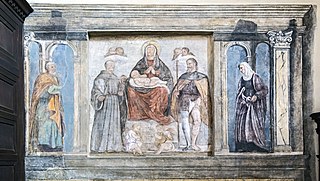
Girolamo Tessari, also called Gerolamo Tessari or Girolamo dal Santo, was an Italian painter, active in a Renaissance style in his native city of Padua.

San Francesco is a Roman Catholic church, located on Piazza Cavalli #68 in Piacenza, Italy. It was built in a style described as Lombard Gothic and is centrally located facing towards the Piazza del Cavalli, which is surrounded by the Palazzo Gotico and the Palazzo del Governatore.
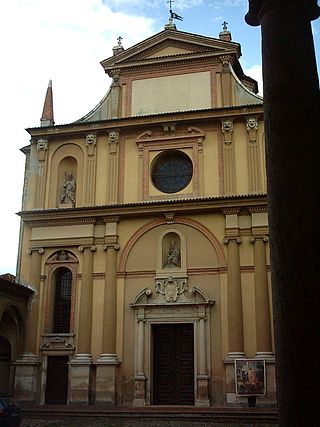
San Sisto is a Renaissance style, Roman Catholic church, located on the Via of the same name in north-central Piacenza, Region of Emilia Romagna, Italy.

The Church of Our Lady of the Graces is a Gothic-style, Roman Catholic church in Varallo Sesia, province of Vercelli, region of Piedmont, Italy. The church was built, together with the adjacent Franciscan convent, by padre Bernardo Caimi between 1486 and 1493. At this time, the construction of the Sacro Monte was also beginning. In December 1931, Pope Pius XI gave the church the title of Minor Basilica.
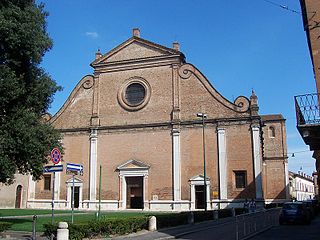
San Francesco is a late-Renaissance, Roman Catholic minor basilica church located on via Terranuova in Ferrara, Emilia-Romagna, Italy.

Santa Maria in Vanzo is a Renaissance-style, Roman Catholic church in Padua, region of Veneto, Italy.

Santa Caterina d'Alessandria or Saint Catherine of Alexandria is a Roman Catholic church with a main facade on Piazza Bellini, and a lateral Western facade facing the elaborate Fontana Pretoria, in the historic quarter of Kalsa in the city of Palermo, region of Sicily, Italy. In front of the main facade, across the piazza Bellini, rise the older churches of San Cataldo and Santa Maria dell'Ammiraglio, while across Piazza Pretoria is the Theatine church of San Giuseppe and the entrance to the Quattro Canti. Refurbished over the centuries, the church retains elements and decorations from the Renaissance, Baroque, and late-Baroque (Rococo) eras. This church is distinct from the Oratorio di Santa Caterina found in the Olivella neighborhood.
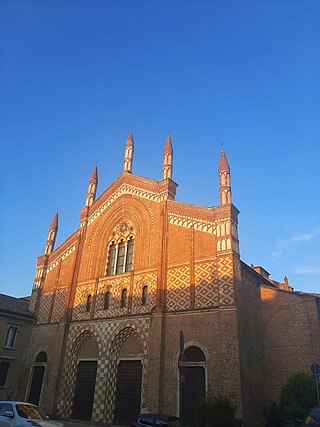
The church of San Francesco of Assisi is a Catholic religious building in Pavia, Lombardy, Italy.